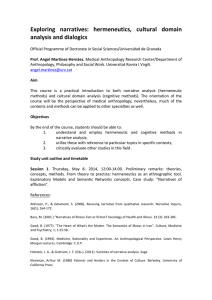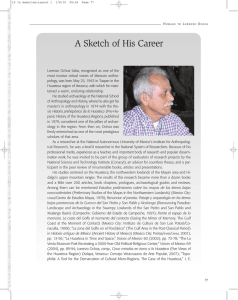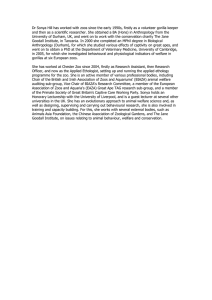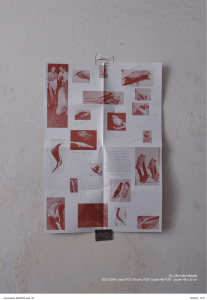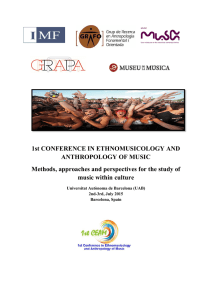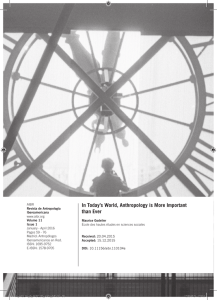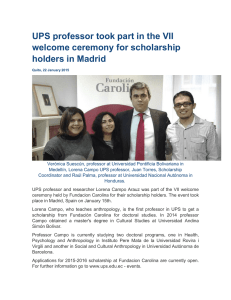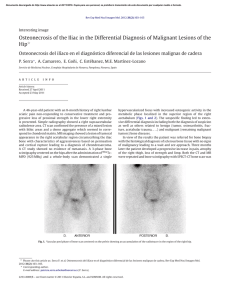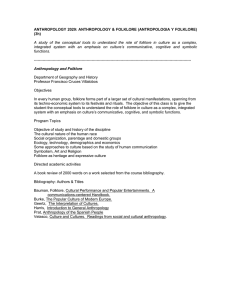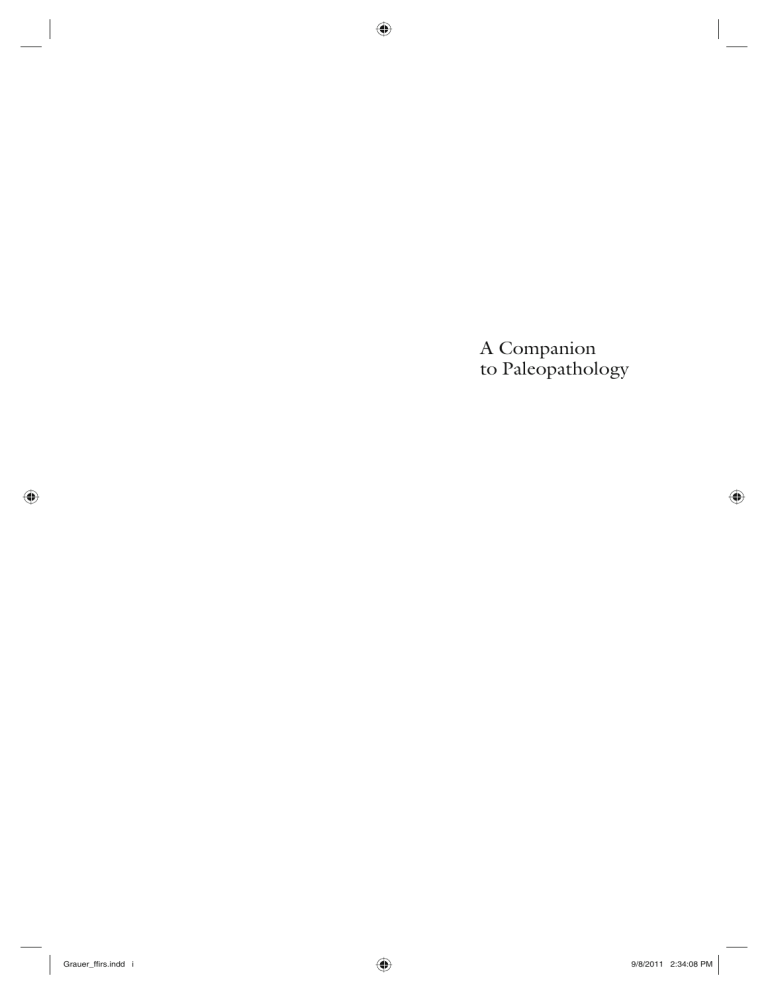
A Companion to Paleopathology Grauer_ffirs.indd i 9/8/2011 2:34:08 PM The Blackwell Companions to Anthropology offers a series of comprehensive syntheses of the traditional subdisciplines, primary subjects, and geographic areas of inquiry for the field. Taken together, the series represents both a contemporary survey of anthropology and a cutting edge guide to the emerging research and intellectual trends in the field as a whole. 1. A Companion to Linguistic Anthropology edited by Alessandro Duranti 2. A Companion to the Anthropology of Politics edited by David Nugent and Joan Vincent 3. A Companion to the Anthropology of American Indians edited by Thomas Biolsi 4. A Companion to Psychological Anthropology edited by Conerly Casey and Robert B. Edgerton 5. A Companion to the Anthropology of Japan edited by Jennifer Robertson 6. A Companion to Latin American Anthropology edited by Deborah Poole 7. A Companion to Biological Anthropology edited by Clark Larsen (hardback only) 8. A Companion to the Anthropology of India edited by Isabelle Clark-Decès 9. A Companion to Medical Anthropology edited by Merrill Singer and Pamela I. Erickson 10. A Companion to Cognitive Anthropology edited by David B, Kronenfeld, Giovanni Bennardo, Victor de Munck, and Michael D. Fischer 11. A Companion to Cultural Resource Management edited by Thomas King 12. A Companion to the Anthropology of Education edited by Bradley A.U. Levinson and Mica Pollack 13. A Companion to the Anthropology of the Body edited by Frances E. Mascia-Lees 14. A Companion to Paleopathology edited by Anne L. Grauer Forthcoming A Companion to Forensic Anthropology edited by Dennis Dirkmaat A Companion to the Anthropology of Europe edited by Ullrich Kockel, Máiréad Nic Craith, and Jonas Frykman A Companion to Paleoanthropology edited by David Begun Grauer_ffirs.indd ii 9/8/2011 2:34:09 PM A Companion to Paleopathology Edited by Anne L. Grauer A John Wiley & Sons, Ltd., Publication Grauer_ffirs.indd iii 9/8/2011 2:34:09 PM This edition first published 2012 © 2012 Blackwell Publishing Ltd. Blackwell Publishing was acquired by John Wiley & Sons in February 2007. Blackwell’s publishing program has been merged with Wiley’s global Scientific, Technical, and Medical business to form Wiley-Blackwell. Registered Office John Wiley & Sons Ltd, The Atrium, Southern Gate, Chichester, West Sussex, PO19 8SQ, UK Editorial Offices 350 Main Street, Malden, MA 02148-5020, USA 9600 Garsington Road, Oxford, OX4 2DQ, UK The Atrium, Southern Gate, Chichester, West Sussex, PO19 8SQ, UK For details of our global editorial offices, for customer services, and for information about how to apply for permission to reuse the copyright material in this book please see our website at www.wiley.com / wiley-blackwell. The right of Anne L. Grauer to be identified as the author of the editorial material in this work has been asserted in accordance with the UK Copyright, Designs and Patents Act 1988. All rights reserved. No part of this publication may be reproduced, stored in a retrieval system, or transmitted, in any form or by any means, electronic, mechanical, photocopying, recording or otherwise, except as permitted by the UK Copyright, Designs and Patents Act 1988, without the prior permission of the publisher. Wiley also publishes its books in a variety of electronic formats. Some content that appears in print may not be available in electronic books. Designations used by companies to distinguish their products are often claimed as trademarks. All brand names and product names used in this book are trade names, service marks, trademarks or registered trademarks of their respective owners. The publisher is not associated with any product or vendor mentioned in this book. This publication is designed to provide accurate and authoritative information in regard to the subject matter covered. It is sold on the understanding that the publisher is not engaged in rendering professional services. If professional advice or other expert assistance is required, the services of a competent professional should be sought. Library of Congress Cataloging-in-Publication Data A companion to paleopathology / edited by Anne L. Grauer. p. cm. – (Blackwell companions to anthropology) Includes bibliographical references and index. ISBN 978-1-4443-3425-8 (hardback : alk. paper) 1. Paleopathology. I. Grauer, Anne L., 1958– R134.8.C65 2012 614′.17–dc23 2011018221 A catalogue record for this book is available from the British Library. This book is published in the following electronic formats: ePDFs 9781444345919; Wiley Online Library 9781444345940; ePub 9781444345926; mobi 9781444345933 Set in 10/12.5pt Galliard by SPi Publisher Services, Pondicherry, India 1 Grauer_ffirs.indd iv 2012 9/8/2011 2:34:09 PM To Peter, Evelyn, and Thomas for their love (and patience) Grauer_ffirs.indd v 9/8/2011 2:34:09 PM Contents List of Illustrations xi List of Tables xvii Notes on Contributors xix Acknowledgements xxviii 1 Introduction: The Scope of Paleopathology Anne L. Grauer 1 Part I Approaches, Perspectives and Issues 15 2 Ethics and Issues in the Use of Human Skeletal Remains in Paleopathology Patricia M. Lambert 17 3 Evolutionary Thought in Paleopathology and the Rise of the Biocultural Approach Molly K. Zuckerman, Bethany L. Turner, and George J. Armelagos 34 4 The Bioarchaeological Approach to Paleopathology Michele R. Buzon 58 5 The Molecular Biological Approach in Paleopathology James H. Gosman 76 6 The Ecological Approach: Understanding Past Diet and the Relationship Between Diet and Disease M. Anne Katzenberg 7 An Epidemiological Approach to Paleopathology Jesper L. Boldsen and George R. Milner Grauer_ftoc.indd vii 97 114 9/7/2011 3:23:11 PM viii 8 9 CONTENTS The Promise, the Problems, and the Future of DNA Analysis in Paleopathology Studies Mark Spigelman, Dong Hoon Shin, and Gila Kahila Bar Gal The Analysis and Interpretation of Mummified Remains Michael R. Zimmerman 133 152 10 The Study of Parasites Through Time: Archaeoparasitology and Paleoparasitology Katharina Dittmar, Adauto Araújo, and Karl J. Reinhard 170 11 More Than Just Mad Cows: Exploring Human–Animal Relationships Through Animal Paleopathology Beth Upex and Keith Dobney 191 12 How Does The History of Paleopathology Predict its Future? Mary Lucas Powell and Della Collins Cook 214 Part II Methods and Techniques of Inquiry 225 13 A Knowledge of Bone at the Cellular (Histological) Level is Essential to Paleopathology Bruce D. Ragsdale and Larisa M. Lehmer 227 14 Differential Diagnosis and Issues in Disease Classification Donald J. Ortner 250 15 Estimating Age and Sex from the Skeleton, a Paleopathological Perspective George R. Milner and Jesper L. Boldsen 268 16 The Relationship Between Paleopathology and the Clinical Sciences Simon Mays 285 17 Integrating Historical Sources with Paleopathology Piers D. Mitchell 18 Fundamentals of Paleoimaging Techniques: Bridging the Gap Between Physicists and Paleopathologists Johann Wanek, Christina Papageorgopoulou, and Frank Rühli 19 Data and Data Analysis Issues in Paleopathology Ann L.W. Stodder Part III Diseases of the Past: Current Understandings and Controversies 310 324 339 357 20 Trauma Margaret A. Judd and Rebecca Redfern 359 21 Developmental Disorders in the Skeleton Ethne Barnes 380 Grauer_ftoc.indd viii 9/7/2011 3:23:11 PM CONTENTS ix 22 Metabolic and Endocrine Diseases Tomasz Kozłowski and Henryk W. Witas 401 23 Tumors: Problems of Differential Diagnosis in Paleopathology Don Brothwell 420 24 Re-Emerging Infections: Developments in Bioarchaeological Contributions to Understanding Tuberculosis Today Charlotte Roberts 434 25 Leprosy (Hansen’s disease) Niels Lynnerup and Jesper Boldsen 458 26 Treponematosis: Past, Present, and Future Della Collins Cook and Mary Lucas Powell 472 27 Nonspecific Infection in Paleopathology: Interpreting Periosteal Reactions Darlene A. Weston 492 28 Joint Disease Tony Waldron 513 29 Bioarchaeology’s Holy Grail: The Reconstruction of Activity Robert Jurmain, Francisca Alves Cardoso, Charlotte Henderson, and Sébastien Villotte 531 30 Oral Health in Past Populations: Context, Concepts and Controversies John R. Lukacs 553 Index 582 Grauer_ftoc.indd ix 9/7/2011 3:23:12 PM List of Illustrations Figure 6.1 Delta notation for stable isotope ratios Figure 6.2 Stable isotope analysis of modern plants collected from West Central Chihuahua, Mexico. There is a wide range of variation in both δ13C and δ15N values. C3 plants include juniper, pinon pine, onion and walnut. C4 plants include maize, sorghum and dropseed grass. CAM plants include agave, stool and prickly pear cactus. (Webster and Katzenberg 2009). Figure 6.3 Caries incidence increases as more maize is consumed, as reflected in increasing δ13C values from four sites in southern Ontario: (from left to right) Serpent Mounds, Surma, Serpent Pits and Bennett. Figure 7.1 A deliberately simplified example where of 10,000 births, 1,000 people had a lesion and the remainder did not. Individuals with the lesion experienced a constant mortality rate of 0.1, whereas the others had a rate of 0.05. The lines show the frequencies of individuals at each age with the lesion in the cemetery sample (solid line) and living population (broken line). Throughout life, there were proportionately more individuals with the lesion at each age in the cemetery (dead) than there were in the community (alive) from which the dead were drawn. Figure 7.2 Somewhere between 8.1 and 32.3 percent of the individuals in the once-living population suffered from a particular disease, as estimated from the following information. The lesion is known to be present in 80 percent of individuals with the disease of interest, and it is present in 30 percent of people without that disease; and the lesion is found in 100 of 250 excavated skeletons. The horizontal line is the 95 percent confidence interval cutoff line, so the disease frequency interval is demarcated by the part of the log-likelihood curve that lies above the line. Grauer_flast.indd xi 9/6/2011 11:11:05 AM xii LIST OF ILLUSTRATIONS Figure 7.3 A Well–Sick–Dead model derived from Usher (2000) that is of potential use to paleoepidemiologists. Individuals can undergo a transition from Well to Sick, and from both Well and Sick to Dead. The Dead category, of course, can be counted in an archaeological sample; the Well and Sick have to be estimated. The model is interesting because parameter values that can be derived from it are descriptive of life in the past. Much information is contained in the κ-parameter, as it describes the relative mortality risk experienced by people with a given lesion compared to people without it. Figure 13.1 Typical bone tumor locations as they relate to events of normal growth and development. Figure 13.2 Giant cell tumor of bone, distal radius. [Left column]: gross view of longitudinally saw-cut specimen (top) and large format histological section (bottom) with the new ridged shell-type periosteal reaction that replaced original cortex along the right side of the tumor. [Center column]: macerated specimens of the ridged shell-type periosteal reaction, endosteal surface (top) periosteal surface (bottom). [Right column]: scanning electron micrographs – Endosteal surface (top) displaying overlapping Howship’s lacunae, exposing an elliptical osteocyte lacuna and above that, a somewhat erosion-resistant cement line (1300x). The periosteal surface (bottom) pockmarked by shallow depressions where osteoblasts were settling in as osteocytes beneath a layer of unmineralized osteoid, removed during maceration (520x). Figure 13.3 Infected non-union of distal tibia. External (A) and internal (C) views of proximal and distal macerated tibia segments flank the saw-cut fresh specimen (B). The gap shown in “A” and “C” was occupied by a gristlelike fibrocartilage band that triggered enchondral ossification where it contacted bone as an attempt toward bony union (D). Would the histopathology of dry bone “C” predict this pathologic enchondral ossification? Figure 13.4 Sickle cell disease. A: Saw cut fresh autopsy bones of the adult male who died in sickle cell crisis (Faerman et al. 2000). Proximal radius (left) and distal humerus (center) have old sclerotic residua of bone infarcts appearing white against the hyperplastic red marrow filling the bones. A recent infarct appears white in the distal diaphyseal marrow of the proximal humeral segment. B: Same specimens after chemical (papain) maceration display larger than normal cancellous modules. C: Ground section at extreme right viewed under polarized light (courtesy of Michael Schultz, MD; 40x). Figure 14.1 (A) Woven bone fracture callus in the diaphysis of an adult right humerus (NMNH 364816-32). (B) Cutback zone (arrow) in the proximal metaphysis of the right tibia in a 4-year-old child from an archaeological site in the American southwest (NMNH 326194). (C) Osteosarcoma arising on the left ilium in a modern 25-year-old male (Institute of Pathological Anatomy, University of Zurich 389/69). Note the poor Grauer_flast.indd xii 9/6/2011 11:11:05 AM LIST OF ILLUSTRATIONS xiii organization of the bone. (D) Bone-forming lesion of the tibial shaft in an adult male from a postcontact archeological site in Canaveral, Florida (NMNH 377457). Note the area of porosity in the central area of the lesion and the compact bone at the margins of the lesion (arrow). (E) Abnormal rachitic bone separated from earlier spongy bone by fine spicules of trabecular bone connecting the two areas of bone. Section through the skull vault of a child 2 years of age with rickets (Federal Pathologic-Anatomy Museum, Vienna, Austria catalog no. 5251). (F) Abnormal compact bone formation on the medial and anterior surfaces (arrow) of the right tibia in a case of treponematosis. Male, 30 years old, from a prehistoric site in Virginia (USA NMNH 385788). Figure 14.2 (A) Lesion characterized by a failure to form bone resulting from the presence of a congenital epidermoid cyst. Note the compact bone margins of the lesion indicative of a benign condition; modern 61-year – old male (Department of Pathology, University of Strasbourg, France catalog no. 7878). (B) Destructive lesions with reactive bone formation at the margins of the lesion in a case of treponematosis. Frontal bone from an adult male about 35 years of age from a medieval site at the Hull Magistrate’s Court, Hull, England (burial no. 1216). (C) Earlystage porous destructive bone lesion in a case of treponematosis. Frontal bone from an adult male about 35 years of age from a medieval site at the Hull Magistrate’s Court, Hull, England (burial no. 1216). (D) Porosity and eburnation of subchondral bone in the left femoral head in a modern adult femur (Museum of Man, San Diego, California catalog no. 1981-30-755). (E) Multiple “punched out” lytic lesions of the cranium in an adult female skull about 35 years of age from an archaeological site near Caudivilla, Peru dated between 500 and 1530 A.D. The destructive lesions were caused by multiple myeloma. Note the large lesion in the right central portion of the figure with lobulated margins that probably represents the coalescence of several smaller lesions. Note also that there is no evidence of reactive bone formation associated with any of the lesions (NMNH 242559). (F) Aggressive bone destruction in the right anterior temporal, sphenoid and parietal bones in a probable case of metastatic carcinoma. Note the very ragged and poorly defined margins of the lesion. Adult female 17th century from Varangerfjord, Norway (NMNH 241876). Figure 14.3 (A) Right femur from a fetus with achondroplasia. Note the flared metaphyses that are abnormally wide relative to the length of the femur. Growth in width is minimally affected in achondroplasia so that the margins of the metaphyses are relatively normal in size. (From the Wellcome Museum, Royal College of Surgeons of England, London catalog no. S59.3.) (B) Posterior views of the left (lower) and right tibias of a child about 9 years of age with osteomyelitis of the left tibia from an archaeological site near La Otoya, Peru dated between 1400 and 1530 A.D. Note the greater length of the abnormal tibia in which the growth process was stimulated by chronic inflammation (NMNH 378243). Grauer_flast.indd xiii 9/6/2011 11:11:05 AM xiv LIST OF ILLUSTRATIONS (C) Abnormal size apparent in the cranium in the left of the figure compared with a normal cranium in the right portion of the figure. The abnormal size is caused by a defect in the pituitary gland which secreted excessive growth hormone during development. (Photo courtesy of Dr. Takao Suzuki, Shinjyuku-ku, Tokyo, Japan.) (D) Severe deformity in a case of rickets resulting from a deficiency in vitamin D in a male about 18 years of age at the time of death. Note the inward collapse of the pelvis caused by the weight of the body on the femoral heads. (Department of Pathology, University of Strasbourg, France catalog number 7664d.) (E) Left lateral view of a cranium with premature fusion of the sagittal suture resulting in an elongated cranium. Adult male from a pre-Columbian site in Cinco Cerros region of Peru (NMNH 293841). Figure 15.1 A comparison of actual and estimated ages for 239 modern American (Bass Collection) skeletons examined by Milner. Ages were estimated with the current Transition Analysis program, and they are based on pelvic and cranial characteristics, as well as a uniform prior distribution. The diagonal line indicates a perfect match between actual and estimated ages. Note that a large fraction of the sample is over 50 years, a part of the lifespan commonly handled through the use of a terminal open-ended age interval. Figure 15.2 A comparison of the actual and estimated ages of the same 239 modern American (Bass Collection) skeletons, with the estimates being experience-based impressions based on a wide array of characteristics distributed throughout the skeleton. The diagonal line indicates a perfect match between actual and estimated ages. These results indicate there is much more that is informative about age than is captured by conventional methods of scoring skeletal structures that emphasize the pelvis, cranium, and ribs. Figure 15.3 Humeral head diameters (mm) that correspond to an equal probability of a skeleton being female or male are not the same in study samples with different sex ratios. When females are disproportionately represented in the sample of skeletons, perhaps because they came from an excavated convent cemetery, one can expect that large bones are more likely to be from females than they would be in a sample that had few women but many men. Figure 16.1 Lateral radiograph of a tibia from a medieval case of Paget’s disease of bone (PDB). The diseased proximal part of the bone has a mottled appearance and shows loss of corticomedullary distinction. The advancing front of Pagetic bone (arrowed) is V-shaped. (Pinhasi and Mays 2008, Figure 11.7.) Figure 16.2 A histological section of bone from the same individual as Figure 16. 1. The randomly orientated, fragmented lamellar pattern is typical of PDB. (Mays and Turner-Walker 1999, Figure 17b.) Figure 16.3 (a) Porotic hyperostosis of the orbital roofs. (b) Porotic hyperostosis on the ectocranial surface of skull vault fragments. Grauer_flast.indd xiv 9/6/2011 11:11:05 AM LIST OF ILLUSTRATIONS Figure 18.1 xv Dual-energy computed tomography of a mummy head. Grooves for the middle meningeal artery are visible (black arrow) as well as resin-filled areas in the posterior skull base (white arrow). The DECT scan (SOMATOM Definition Dual Source, Siemens, Germany) illustrates a three-dimensional (3-D) volume rendering of the mummy head (tube voltage 100 kVp, tube current 120 mAs, spatial resolution 0.4 mm, matrix size 512 × 512). Figure 19.1 A Peabody Museum Cranial Observation card used by Earnest Hooton, with quantification data for antemortem tooth loss, wear, caries, and other dental conditions from a skeleton excavated in the 1919 season of the Andover Pecos Expedition. Courtesy of the Peabody Museum of Archaeology and Ethnology, Harvard University, [Peabody 2011.1.10]. Figure 19.2 The data recording card used by Earnest Hooton for the majority of the Pecos study, with “+” signs replacing scores for dental wear, and caries count replacing group counts. Courtesy of the Peabody Museum of Archaeology and Ethnology, Harvard University, [Peabody ID 2011.1.11]. Figure 19.3 Osteoware© data entry screen for abnormal bone formation. Courtesy of the National Museum of Natural History. Figure 19.4 Three presentations of a small dataset, with a) showing the raw data alongside averages and standard deviations of the severity of DJD within each age group; b) presenting the data as a bar chart; and c) displaying the data as a scattergram. Data are from Stodder et al. 2010, courtesy of SWCA Environmental Consultants, Inc. Figure 19.5 Back-to-back stem and leaf plot, maximum femur length, for ancestral Pueblo females. Figure 23.1 Examples of pathology and pseudopathology: a and b, lytic lesions in a Hungarian skeleton; c, insect damage to a Socotran femur; d, postmortem skull damage. Figure 23.2 Examples of pathology and normal variation: a, external surface of a prehistoric native American skull showing osteolytic lesions; b, maxillary sinus with remodeled bone indicative of sinusitis; c, endocranial view of a frontal bone displaying deep pachionian impressions. Figure 23.3 Variation in archaeological tumors: (a) small osteoma on the external surface of a medieval skull; (b) much expanded mandibular body of a prehistoric native American, with a displaced molar. Probably a dentigorous cyst; (c) a Neolithic skull from Denmark, displaying bone remodeling in the face as a result of a soft tissue tumor; (d) an odontome in the mandible of a prehistoric Socotran; (e) a medieval tibia from York displaying changes which are probably indicative of an osteoid osteoma; (f ) midshaft of a post-medieval femur from York, displaying deep cortical destruction, indicative of a malignancy. Figure 23.4 Further examples of bone changes in tumor development: (a) zones of osteoblastic surface changes in an ancient Peruvian female, Grauer_flast.indd xv 9/6/2011 11:11:05 AM xvi LIST OF ILLUSTRATIONS probably indicative of a metastatic carcinoma; (b) mandible from Saxon Winchester, with a lytic lesion and reactive marginal bone (Codman’s triangle), probably indicating a metastatic deposit; (c) a Nubian lumbar vertebra with a rounded inner chamber and external opening, possibly indicating a hemangioma; (d) the femur of a Vth Dynasty Egyptian, displaying changes typical of an osteochondroma. Figure 27.1 Types of periosteal new bone production (after Ragsdale et al. 1981). Figure 27.2 Various types of periosteal reaction (after Resnick 1995). Figure 27.3 An illustration of Strothers’ and Metress’ (1975) four stages of plaquelike periostitis. Figure 28.1 Classification of joint disease. Figure 28.2 Factors contributing to joint failure (osteoarthritis). Figure 30.1 Allied fields contributing to the advancement of knowledge of dental paleopathology. Figure 30.2 Examples of pathological conditions found in human dental remains: a) dislocation of RM1 and antemortem loss of teeth due to severe wear (MDH 23); b) antemortem loss (RM2–3), pulp exposure and periapical abscesses resulting from severe occlusal wear (P3–4; HAR 148a); c) large carious lesion (LM3) exposing pulp chamber (SKH 5); d) medium-size calculus deposits, lingual aspect, left P4 through M2 (SKH 12) (note calculus removed from LM3, only traces present); e) transposed upper left canine. Canine crown carious, large LI2–P3 diastema (HAR 156a); and f ) linear enamel hypoplaisa (LEH) four defects visible in LI1. Severe episodes matched on I1, I2 and C indicating systemic stress (MR2 60) (all photos J. R. Lukacs). Figure 30.3 Examples of rotation of maxillary P4: a) maxilla, Homo floresiensis (LB 1), showing bilateral rotation of P4s (Brown et al. 2004; photo courtesy of Peter Brown); b) maxillary dentition, adult female (MR3 183) Neolithic Mehrgarh, with bilaterally rotated P4s (photo J. R. Lukacs); c) maxillary dentition (MR3 283), Neolithic Mehrgarh, with bilateral 45 degree rotation of P4 inferred from interproximal wear facets (photo J. R. Lukacs); and d), maxillary dentition of an adult Chenchu female (CHU 73) with bilateral rotation and reduced crown size of P4 associated with reduced crown size of RI2 (photo G. C. Nelson). Grauer_flast.indd xvi 9/6/2011 11:11:05 AM List of Tables Table 9.1 Abbreviated list of conditions found in human mummified remains Table 13.1 The twelve basic principles of orthopedic pathology Table 13.2 The seven basic categories of disease Table 13.3 The three fundamental inflammatory patterns Table 16.1 Citation frequency of case reports versus other types of study in clinical sciences and in paleopathology Table 17.1 Twelve pitfalls in retrospective diagnosis that can result in errors Table 17.2 Aspects of a source that optimizes reliability in retrospective diagnosis Table 18.1 Strengths and weaknesses of THz-imaging of normal and dehydrated tissue Table 18.2 Comparison between CLSM, wide-field microscopy and micro-CT Table 18.3 Imaging modality and its benefit in paleopathology (invasive modalities are shaded) Table 21.1 Developmental field disorders of the skull Table 21.2 Developmental field disorders of the vertebral column Table 21.3 Developmental field disorders of the ribs and sternum Table 21.4 Developmental field disorders of the upper limbs Table 21.5 Developmental field disorders of the lower limbs Table 23.1 Some major classes of tumor which can affect the skeleton. Adapted from Stoker (1986) Grauer_flast.indd xvii 9/6/2011 11:11:05 AM xviii LIST OF TABLES Table 24.1 Risk factors for tuberculosis: potential for recognition in the past ( or —) Table 26.1 Pathological changes caused by treponemal syndromes Table 27.1 Types of periosteal new bone production (after Edeiken et al. 1966, Edeiken 1981) Table 27.2 Types of periosteal new bone production (after Ragsdale et al. 1981; Ragsdale 1993) Table 27.3 Types of periosteal new bone production (Strothers and Metress 1975) Table 27.4 Stages of severity of tibial infection (Lallo 1973) Table 27.5 System for scoring periosteal new bone production and periosteal vascularization (Cook 1976) Table 28.1 Rank order of osteoarthritis at different sites; modern (radiological) and archaeological data Table 28.2 Subsets of psoriatic arthropathy in order of occurrence Table 30.1 World Health Organization’s international classification of disease Table 30.2 Pathological lesions commonly observed in teeth and jaws of archaeologically derived human skeletons Table 30.3 Tabular guide to topical coverage of oral pathology and related conditions Table 30.4 Changing global coverage of health and subsistence transition Grauer_flast.indd xviii 9/6/2011 11:11:05 AM Notes on Contributors Adauto Araújo is Senior Researcher at Fundação Oswaldo Cruz, Rio de Janeiro, Brazil. His research focus is on paleoparasitology and the origin and evolution of infectious diseases. He is the author of numerous publications, the most recent being Araujo et al. (2009) “Paleoparasitology of Chagas disease: a review,” Memórias do Instituto Oswaldo Cruz. He is a member of the Academia de Medicina do Rio de Janeiro, Sociedade Brasileira de Parasitologia, and the Paleopathology Association. George J. Armelagos is Goodrich C. White Professor of Anthropology at Emory University. His research has focused on diet and disease in human adaptation. He has co-authored Demographic Anthropology with Alan Swedlund, Consuming Passions with Peter Farb, Paleopathology at the Origins of Agriculture with Mark Cohen. He has been president of American Association of Physical Anthropologists and Chair of the Anthropology Section of the American Association for the Advancement of Science. He received the Viking Fund Medal (2005), anthropology’s highest honor, the Franz Boas Award for Exemplary Service (2008) from the American Anthropological Association, and the Charles Darwin Award for Lifetime Achievement from the American Association of Physical Anthropologists (2009). In addition to all of this, he is considered a relatively “good guy.” Gila Kahila Bar Gal is Senior Lecturer at the Koret School of Veterinary Medicine, The Hebrew University of Jerusalem. Her research interests include molecular evolution, co-evolution of host–pathogen, ancient DNA, domestication and conservation genetics. She has published articles in Nature, and PLoS ONE, and most recently has co-authored a paper (Polani et al. 2010) entitled, “Evolutionary dynamics of endogenous feline leukemia virus proliferation among species of the domestic cat lineage,” Virology. Ethne Barnes is a physical anthropologist and paleopathologist, consultant, and independent researcher in Tucson, Arizona. She is recognized for establishing the Grauer_flast.indd xix 9/6/2011 11:11:06 AM xx NOTES ON CONTRIBUTORS morphogenetic approach to analyzing developmental defects of the skeleton in paleopathology. Her research and consultation work includes archaeological projects in Greece, Turkey, China, South America and North America. Major publications include Developmental Defects of the Axial Skeleton in Paleopathology (1994), Diseases and Human Evolution (2005), and “Congenital Anomalies” in Advances in Human Paleopathlogy (Pinhasi and Mays 2008). Jesper Boldsen is Professor of Anthropology and head of ADBOU at the Institute of Forensic Medicine, University of Southern Denmark. His research interests revolve around medieval population biology, epidemiology, demography, evolution and leprosy. Recent publications include: “Early childhood stress and adult age mortality—a study of dental enamel hypoplasia in the medieval Danish village of Tirup,” American Journal of Physical Anthropology (2007); “Leprosy in Medieval Denmark— Osteological and epidemiological analyses,” Anthropologischer Anzeiger (2010). Don Brothwell is Emeritus Professor of Human Palaeoecology in the Department of Archaeology at the University of York, U.K. His research interests are broad-based, incorporating the archaeological and geological context of human remains, along with study of disease across history, space, and a variety of species. His publications include 17 books and over 190 chapters and articles, including Food in Antiquity: A Survey of the Diet of Early Peoples (1998), and Handbook of Archaeological Sciences (2005). Michele R. Buzon is Associate Professor of Anthropology at Purdue University. Her research interests include the interplay of health and identity with sociopolitical changes in Nile Valley during the New Kingdom and Napatan periods using paleopathological, archaeological, and isotopic methods. Recent publications include Buzon and Bowen (2010) “Oxygen isotope analysis of migration in the Nile Valley,” Archaeometry, and Buzon and Bombak (2010) “Dental Disease in the Nile Valley during the New Kingdom,” International Journal of Osteoarchaeology. Francisca Alves Cardoso is Lecturer in Biological Anthropology in the Institute of Philosophy and Human Sciences in the Federal University of Pará, Brazil, and a Research Fellow of CRIA—Centre for Research in Anthropology, Portugal. Her most recent research focuses on the importance of socioeconomic and cultural variables in the interpretation of human remains, having previously discussed gender and activityrelated issues as her PhD topic: “A Portrait of Gender in Two 19th/20th Portuguese Populations: A Paleopathological Perspective.” Della Collins Cook is Professor of Anthropology at Indiana University. Her interests include paleopathology, mortuary practices and history of physical anthropology. While she is an Americanist, she has worked with remains from South Africa, Egypt, Greece, and Portugal. She and her colleagues have published on dental modification, isotopic evidence for nutrition, and biological distance. Her recent publications include The Myth of Syphilis: A Natural History of North American Treponematosis (2005, co-authored with Mary Lucas Powell), and “The Evolution of American Paleopathology,” in Bioarchaeology: The Contextual Study of Human Remains, Buikstra and Beck, eds. (2006). Grauer_flast.indd xx 9/6/2011 11:11:06 AM NOTES ON CONTRIBUTORS xxi Katharina Dittmar is Assistant Professor of Evolutionary Biology at SUNY—Buffalo. Her research focus includes the evolution of parasitism and evolutionary biology. Her recent publications include “Rapid evolution of protein kinase alters the sensitivity to viral inhibitors,” Nature Structural and Molecular Biology (2009) (co-authored with S. Rothenburg et al.), and Dittmar et al. (2006) “Molecular phylogenetic analysis of nycteribiid and streblid batflies (Diptera: Brachycera, Calyptratae): Implications for host association and phylogeographic origins,” in Molecular Phylogenetics and Evolution. Keith Dobney is Sixth Century Chair of Human Palaeoecology in the newly established Archaeology Department at the University of Aberdeen, UK. The main material focus of his work is the study of animal (including human) remains, his principal research being: the origins and spread of agriculture, migration and dispersal, palaeoeconomy, palaeopathology and palaeoepidemiology. He is currently one of two project leaders of a CNRS-funded Projet de Groupement De Recherche Européan (GDRE): “BIOARCH- Bioarchaeological Investigations of the Interactions between Holocene Human Societies and their Environments,” and the Director of a similar (Co-Reach funded) Chinese-European research grouping (EUCH-BIOARCH). James H. Gosman is Adjunct Assistant Professor in Anthropology at The Ohio State University, and an orthopedic surgeon by training. His research interest encompasses skeletal biology and bioarchaeology, with particular focus on human trabecular bone ontogeny and locomotor development. Recent publications include, Gosman and Ketcham (2009), “Patterns in ontogeny of human trabecular bone from SunWatch village in the prehistoric Ohio Valley: General features of microarchitectural change,” American Journal of Physical Anthropology, and Gosman and Stout (2010) “Current concepts in skeletal biology,” in A Companion to Biological Anthropology, ed. Larsen. Anne L. Grauer is Professor of Anthropology at Loyola University Chicago. Her research interests include issues of gender in human skeletal analyses, particularly in North American historic and British medieval populations. She has served as an Associate Editor for the AJPA and on the Executive Board of the AAPA. She is currently the Past-President of the Paleopathology Association. Her publications include Bodies of Evidence: Reconstructing History Through Skeletal Analysis (editor) (1995), Sex and Gender in Paleopathological Perspective (edited with Stuart-Macadam) (1998), and most recently, Fitch, Grauer, and Augustine (2010), “Lead Isotope Ratios: Tracking the Migration of European Americans to Grafton, Illinois in the 19th Century,” International Journal of Osteoarchaeology. Charlotte Henderson is an Honorary Research Associate in the Department of Archaeology, Durham University (U.K.). She is a member of the International Working Group on methods for recording entheseal changes (EC) (http://www.uc.pt/en/ cia/msm/msm_after). Her research focuses on quantitative methods for studying EC along with their etiology, particularly pathological. Her Ph.D. dissertation (2009) was titled “Musculo-skeletal stress markers in bioarchaeology: indicators of activity levels or human variation? A re-analysis and interpretation.” Grauer_flast.indd xxi 9/6/2011 11:11:06 AM xxii NOTES ON CONTRIBUTORS Margaret A. Judd is Associate Professor in the University of Pittsburgh’s Department of Anthropology. She is currently excavating a Byzantine crypt at Mount Nebo in Jordan, following several years of excavation in Sudan and Jordan. Research interests include trauma and health consequences of social, ideological and technological change. Most recent publications include Growing up Gabati (in press), and “Pubic symphyseal face eburnation: An Egyptian sport story?” International Journal of Osteoarchaeology (2010). Robert Jurmain is Professor Emeritus of Anthropology at San Jose State University, California. His research focus concerns paleopathology of humans and nonhuman primates, most specifically, degenerative joint disease and trauma. He has authored articles in numerous peer-reviewed journals and contributions to edited volumes. He is author of Stories from the Skeleton: Behavioral Reconstruction in Human Osteology (1999) as well as coauthor of three textbooks in physical anthropology and archaeology, now in a total of 30 editions. M. Anne Katzenberg is Professor of Physical Anthropology, Department of Archaeology, University of Calgary, Canada. Her research focuses on reconstructing past diet and health using stable isotopes, and refining interpretations of stable isotope data. She is a Fellow of the Royal Society of Canada, and co-editor of the book, Biological Anthropology of the Human Skeleton (2000), with Shelley R. Saunders. She has published numerous stable isotope studies of past peoples from North and South America, Europe and Asia. Tomasz Kozłowski is Assistant Professor, Department of Anthropology, at Nicolaus Copernicus University in Toruń (Poland). His interests include bioarchaeology and paleopathology, focusing on the early mediaeval settlement complex in Kałdus (Poland) and studying the relics of Neolithic settlement in Catalhoyuk in Turkey. He is a member of the Global History of Health Project. His recent publications include “Human bone remains,” in W. Chudziak (ed.), Early Mediaeval Skeleton Cemetery in Kaldus, Mons Sancti Laurentii, Vol. 5 (2010), and co-editor with M. Grupa, Kwidzyn Cathedral—The Mystery of the Crypts (2009). Patricia M. Lambert is Professor of Biological Anthropology and Associate Dean of Research in the College of Humanities and Social Sciences at Utah State University. She served as Associate Editor of the AJPA from 2002 to 2008 and Executive Committee Member for the American Association of Physical Anthropologists from 2006 to 2009. Her research focuses on prehistoric health and violence in the Americas. Recent publications include “Health versus fitness: competing themes in the origins and spread of agriculture,” Current Anthropology (2009). Larisa M. Lehmer is Research Associate in the Dermatopathology division of Central Coast Pathology Consultants in San Luis Obispo, CA, and investigates topics in dermatopathology and osteopathology. Her publications include “MEC of the parotid gland presenting as periauricular cystic nodules,” Journal of Cutaneous Pathology, “Expectorated rhabdomyosarcoma: case report and review of the literature,” Human Pathology, and “Cutaneous metastasis of osteosarcoma in the scalp” American Journal of Dermatopathology. Grauer_flast.indd xxii 9/6/2011 11:11:06 AM NOTES ON CONTRIBUTORS xxiii John R. Lukacs is Professor Emeritus of Anthropology at the University of Oregon in Eugene, OR. His research focuses on the paleopathology and dental anthropology of prehistoric and living South Asians. Recent publications appear in: Current Anthropology, Comparative Dental Morphology, and Clinical Oral Investigations. A monograph on the bioarchaeology of early Holocene foragers of India is nearing completion for publication in British Archaeological Reports. Niels Lynnerup is Professor of Forensic Anthropology, and head of the Unit of Forensic Anthropology at the University of Copenhagen. His research comprises both the living (photogrammetry, gait analyses) as well as the dead (paleodemography, stable isotopes and CT-scanning and 3-D visualisation techniques). Key publications include “Computed tomography scanning and three-dimensional visualization of mummies and bog bodies,” Advances in Human Paleopathology (2008), and “Mummies,” Yearbook of Physical Anthropology (2007). He has recently served as the Vice-president of the Paleopathology Association and is co-editor of the Journal of Paleopathology. Simon Mays is Human Skeletal Biologist for English Heritage. His research covers all areas of archaeological human remains. He is currently an Associate Editor for the American Journal of Physical Anthropology. Key publications include Advances in Human Palaeopathology (edited with R. Pinhasi 2008), and The Archaeology of Human Remains, second edition (2010). George R. Milner is Professor of Anthropology at The Pennsylvania State University. His osteological research focuses on paleopathology (including trauma) and paleodemography, and includes the development of new means of skeletal age estimation for both archaeological and forensic purposes. Recent publications include (with Buikstra and Wiant) “Archaic burial sites in the midcontinent,” in Archaic Societies: Diversity and Complexity Across the Midcontinent (Emerson, McElrath, and Fortier, eds., 2009), and (with Wood and Boldsen) “Advances in paleodemography,” in Biological Anthropology of the Human Skeleton, 2nd edition (Katzenberg and Saunders, eds., 2008). Piers D. Mitchell is Affiliated Lecturer at the University of Cambridge. He has a doctorate in medical history and is also a medical practitioner specializing in children’s orthopedic surgery. His recent publications include Medicine in the Crusades: Warfare, Wounds and the Medieval Surgeon (2004) and Anatomical Dissection in Enlightenment Britain and Beyond: Autopsy, Pathology and Display (2011). Donald J. Ortner is Biological Anthropologist in the Department of Anthropology, Smithsonian Institution. His research emphasis is on disease in archeological human skeletal remains. He has done fieldwork in Jordan and has conducted research projects in the United States, Europe, and Australia. From 1999 to 2001, he was president of the Paleopathology Association. Recent major publications include: Identification of Pathological Conditions in Human Skeletal Remains (2003), EB I Tombs and Burials of Bâb edh-Dhrâ, Jordan (2008) with Frohlich, and “Ecology, culture and disease in past human populations,” (with Schutkowski), in H. Schutkowski, ed, Between Biology and Culture (2008). Grauer_flast.indd xxiii 9/6/2011 11:11:06 AM xxiv NOTES ON CONTRIBUTORS Christina Papageorgopoulou is Alexander von Humboldt Postdoctoral Fellow at the Workgroup of Palaeogenetics, Institute of Anthropology, Johannes GutenbergUniversity, Mainz, Germany and a Research Fellow at the Centre for Evolutionary Medicine, University of Zurich, Switzerland. Her main interests center on new methods in palaeopathology, variability in human growth and development in past populations, and the Mesolithic-Neolithic transition in southeastern Europe from a genetic perspective. She is currently the editor of the Bulletin der Schweizerischen Gesellschaft für Anthropologie, and the Newsletter of the American Dermatoglyphics Association. Mary Lucas Powell is Former Director/Curator of the W. S. Webb Museum of Anthropology at the University of Kentucky, and Editor Emerita of the Paleopathology Newsletter. Her research has focused on the relationship between diet and dental health, and the natural history and paleoepidemiology of treponemal disease and tuberculosis in prehistoric Native American populations in the Southeastern United States and Torre de Palma, a late Classical/medieval site in eastern Portugal. She recently published The Myth of Syphilis: The Natural History of Treponematosis in North America (2005) with co-author, D.C. Cook. Bruce D. Ragsdale is Smithsonian Research Associate and Adjunct Professor of Anthropology at Arizona State University, and a practicing pathologist. He apprenticed with Walter Putschar at Massachusetts General Hospital, worked a decade with Lent Johnson at AFIP, has been on the faculty of nine medical schools. He has co-chaired 20 workshops at Paleopathology Association meetings, established a bone collection at ASU, and continues to contribute academically at local, state and international levels while directing Western Dermatopathology in California. Rebecca Redfern is Curator of Human Osteology at the Museum of London. Her research interests include trauma, lifecourse and gender studies, focusing on Iron Age and Roman communities in Britain. Publications include: Spitalfields: A Bioarchaeological Study of Health and Disease From a Medieval London Cemetery (MoLA Monograph), and “A re-appraisal of the evidence for violence in the late Iron Age human remains from Maiden Castle hillfort, Dorset, England” in Proceedings of the Prehistoric Society. Karl J. Reinhard is Professor of Environmental Archaeology, School of Natural Resources, University of Nebraska. His research interests include archaeoparasitology, palynology, and paleonutrition. He is the author and co-author of numerous publications, including most recently: Vinton, Perry, Reinhard, Santoro, and Teixeira-Santos (2009) “Impact of empire expansion on household diet: the Inka in northern Chile’s Atacama Desert,” in PLoS ONE 4: e8069, and Araújo, Reinhard, Ferreira, and Gardner (2008) “Parasites: probes for evidence of prehistoric human migrations,” in Trends in Parasitology. Charlotte Roberts is Full Professor of Bioarchaeology at Durham University, U.K., Her research focuses on the interaction of people with their environments in the past, the use of pathogen aDNA analysis to explore the origin and evolution of Grauer_flast.indd xxiv 9/6/2011 11:11:06 AM NOTES ON CONTRIBUTORS xxv infections, the impact of air quality and mobility on health, and the Global History of Health (Ohio State University). She is the author of numerous books and articles, including most recently, Human Remains in Archaeology: A Handbook (2009), and The Bioarchaeology of Tuberculosis. A Global View on a Reemerging Disease (2008), co-authored with J. E. Buikstra. Frank Rühli is Head of the Centre for Evolutionary Medicine at the Institute of Anatomy, University of Zurich, Co-Heads the “Swiss MDiagnostic Imaging of Mummy Project”, and is a research fellow of the Institute of History of Medicine, University of Zurich. His research includes the development and use of imaging techniques, the microevolution of anatomical variations in normal and pathological tissues, and assessing the biological standard of living and state of health of conscripts of the Swiss armed forces. He is the President of the German Society of Anthropology, and Vice-President of the Swiss Society of Anthropology. His many publications appear in both anthropological and medical journals. Dong Hoon Shin is Associate Professor at Seoul National University. He has led the Anthropology and Paleopathology Laboratory, Department of Anatomy/ Institute of Forensic Medicine. During the past decade, he has performed aDNA, paleoparasitological, anthropometric and paleoradiological work on the samples from archaeological fields of Korea. He was a scientific committee member of the Korean Association of Physical Anthropologists and aDNA, 2010, in Munich, and is the author of numerous articles. Mark Spigelman is Visiting Professor, Department of International Health, Royal Free and University College London Medical School, and Hebrew University Medical School, Jerusalem, Department of Microbiology, and Associate Professor in the Department of Anatomy and Anthropology, Sackler Medical School, Tel Aviv University, Israel. His research centers on paleomicrobiology, survival of biomolecules, the relationship between microbial diseases of the past and today, and developing techniques for minimally destructive sampling of human remains. He is the author of numerous articles, recently co-authoring with Hershkovitz et al. (2008), “Detection and molecular characterization of 9000-Year-Old Mycobacterium tuberculosis from a neolithic settlement in the eastern Mediterranean,” PlosOne. Ann L.W. Stodder is Research Associate at the Field Museum of Natural History in Chicago, Illinois. Her research, in the U.S. Southwest and various parts of Oceania, addresses paleoepidemiology, mortuary ritual, and human taphonomy. She has recently published two edited volumes: Reanalysis and Reinterpretation in Southwestern Bioarchaeology (2008) and The Bioarchaeology of Individuals (2011). Bethany L. Turner is Assistant Professor in Anthropology at Georgia State University. Her research focuses on multi-isotopic and osteological analyses of Pre-Columbian Peruvian populations to reconstruct diet, residential mobility, and overall health related to cultural transitions in ancient Andean imperial states. Recent publications include “Partnerships, pitfalls, and ethical concerns in international bioarchaeology,” in Agarwal and Glencross (eds.) Social Bioarchaeology (2010), and “Insights into Grauer_flast.indd xxv 9/6/2011 11:11:06 AM xxvi NOTES ON CONTRIBUTORS immigration and social class at Machu Picchu, Peru based on oxygen, strontium and lead isotopic analysis,” Journal of Archaeological Science (2009). Beth Upex is Research Fellow in the newly established Archaeology Department at the University of Aberdeen. She has a background in human and animal osteoarchaeology and palaeopathology. Her PhD research explored the use of enamel hypoplasia in caprines as a means of interpreting past climatic change and changing animal husbandry practices. Her current research is focused on understanding various aspects of animal domestication and other human/animal interactions through the study of skeletal pathology. Sébastien Villotte is Post-Doctoral Researcher at the University of Exeter, Department of Archaeology. His research focuses on human behavior during European prehistory, including a significant component on methodology. In the last two years, he co-organized four workshops on entheseal changes. His recent publications include “Enthesopathies and activity patterns in the early medieval Great Moravian population: Evidence of division of labour,” International Journal of Osteoarchaeology (2010), and (with Castex, Couallier, Dutour, Knusel, and HenryGambier) “Enthesopathies as occupational stress markers: evidence from the upper limb,” in the American Journal of Physical Anthropology (2010). Tony Waldron is Honorary Professor at the Institute of Archaeology, University College London. His research focuses on both methodological theoretical issues in bioarchaeology and paleopathology. His books include Counting the Dead (1994), Paleoepidemiology: The Measure of Disease in the Past (2007), and Palaeopathology (2009). Johann Wanek is Medical Physicist Assistant at the Anatomical Institute of the University of Zurich. He is particularly interested in X-ray imaging and its impact on ancient DNA using a Monte Carlo based simulation, and the physicochemical properties of mummified tissues. He is currently a reviewer at the AUTOMED 2010 (Automation in Medicine), Swiss Federal Institute of Technology Zurich. Darlene A. Weston is Assistant Professor in the Department of Anthropology at the University of British Columbia and Associated Scientist at the Max Planck Institute for Evolutionary Anthropology. Her research focuses on the biocultural interpretation of infectious disease and stress indicators and the interactions between health and paleodemography in European and Caribbean populations. Key publications include papers in the American Journal of Physical Anthropology, the Journal of Human Evolution and the Journal of Forensic Sciences. Henryk W. Witas is Professor and Head of Department of Molecular Biology, Faculty of Biomedical Sciences and Postgraduate Education at the Medical University of Lodz, Poland. His research concentrates on allelic determinants associated or responsible for pathologic phenotype of monogene and polygene diseases, and those responsible for susceptibility to infectious diseases in historic and prehistoric gene pools. His recent publications include Witas et al. (2007) “Extremely high frequency of autoimmune-predisposing alleles in medieval specimens” J. Zhejiang Grauer_flast.indd xxvi 9/6/2011 11:11:06 AM NOTES ON CONTRIBUTORS xxvii Univ Sci B; and Witas et al. (2010) “Changes in frequency of IDDM-associated HLA DQB, CTLA4 and INS alleles,” International Journal of Immunogenetics. Michael R. Zimmerman is Adjunct Professor of Anthropology at the University of Pennsylvania and Adjunct Professor of Biology at Villanova University. He was recently a Visiting Professor at the University of Manchester’s KNH Centre for Biomedical Egyptology. He is also a retired pathologist. His research interest is in mummy paleopathology. His most recent publication is “Cancer: A new disease, an old disease, or something in between?” with R.A. David, in Nature Reviews Cancer (2010). Molly K. Zuckerman is Assistant Professor at Mississippi State University. Her research focuses on the evolution and social and ecological history of acquired syphilis in early modern England, the evolution of infectious disease and cancer, epidemiological transitions, and the bioarchaeology of gender, inequality, and identity. Recent publications include Harper, Zuckerman, Harper M, Kingston, and Armelagos (in press), “The origin and antiquity of syphilis revisited: an appraisal of Old World PreColumbian evidence for treponemal infection,” Yearbook of Physical Anthropology, and Harper, Zuckerman, and Armelagos (in press), “Correspondence: a possible (but not probable?) case of treponemal disease (Response to Mays et al. 2010),” International Journal of Osteoarchaeology. Grauer_flast.indd xxvii 9/6/2011 11:11:06 AM CHAPTER 1 Acknowledgements I extend my heart-felt thanks to the contributors who so quickly and enthusiastically agreed to participate in this project. Their commitment to the field of paleopathology and respect for scientific discourse has made it an honor to be their colleague. Deep gratitude also goes to the chapter reviewers who helped strengthen the volume and shared each author’s desire to represent the promise of our field. I thank Rosalie Robertson, Senior Editor at Wiley-Blackwell, for the humbling invitation to edit this volume, and Julia Kirk, Project Editor, for cheerfully answering each of my gazillion questions. And last, but not least, many thanks are owed to Alec McAulay, Project Manager, whose keen eye and sense of humor made the final editing and production details enjoyable to complete. Grauer_flast.indd xxviii 9/6/2011 11:11:06 AM
